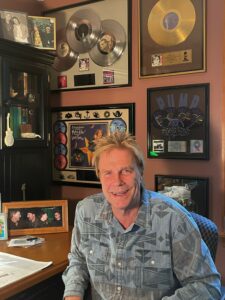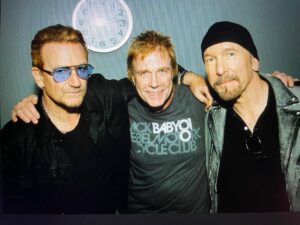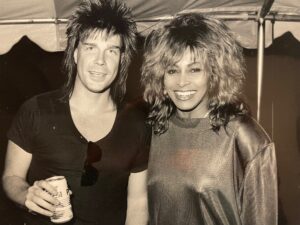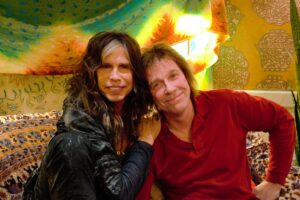By Brett Peruzzi, Managing Editor

BOSTON – Legendary Boston radio DJ Carter Alan originally wanted to be a music writer at a major newspaper. But his immersion in the rock scene ended up putting him behind a microphone instead of a desk.
As a teenager growing up in a small town near Allentown, Penn., Alan went to rock concerts by big-name bands like the James Gang, Deep Purple and Neil Young. He came north to attend New England College in New Hampshire, and after graduating moved to Boston to seek his fortune. He embraced city life and became part of the late 1970s rock club scene.
“There were basically three places booking live rock bands at the time,” he recalled. “The Rat in Kenmore Square, Cantone’s, in the Financial District, which was an Italian restaurant during the day, and The Club, across the Charles River in Central Square in Cambridge.” Through the people he met at shows, he started working as a DJ at MIT’s student-run college radio station, WMBR, which played a diverse range of music and was starting to embrace the emerging punk and new wave bands from England as well as the U.S.
Starting at WBCN

By 1979, his friend and fellow WMBR DJ Oedipus was working at WBCN, “The Rock of Boston” which dominated the city’s airwaves. He brought Alan to the station as a weekend fill-in DJ. “I worked at record stores and painted houses during that time to make ends meet,” Alan recalled, since spinning records part-time wasn’t enough to live on. “WBCN was a genre-crossing radio station,” Alan noted, which gave its DJs lots of freedom to play a wide variety of music. In 1980, Alan was the first DJ in America to play a single by a then little-known teenage Irish band. The song was “I Will Follow,” and the band was U2. The song would hit number 20 on the Billboard charts the next year, and Alan became friendly with the band, who never forgot the early support he gave them. He would eventually go on the road with U2 and later publish two well-received books about the band.
Within a year after joining WBCN, Alan was running the WBCN Rock ‘n’ Roll Rumble, an annual local battle of the bands, which helped launch the careers of local groups who won it, like The Neighborhoods, ‘Til Tuesday, and Gang Green. By 1986 Alan was WBCN’s music director, a position he held for 12 years. In 1998 he moved to classic rock station WZLX at 100.7 FM, where he still works today, as both program director and as a DJ on the midday shift.
As someone who’s been to hundreds of concerts, interviewed dozens of bands, been backstage more times than he can remember, it’s hard for him to narrow down his favorites. “I like all kinds of music,” Alan explained. “Rock, jazz, classical―I’m a subscriber to the Boston Symphony Orchestra. I also had a blues radio show for 19 years.” When pressed, he cites U2, The Who, Pearl Jam and Kate Bush among his all-time favorites.
Writing career came later

Alan’s early ambition to be a writer may have been sidelined for a while, but he’s more than made up for lost time. He has five books to his credit, after writing for numerous rock magazines and newspapers over the years. In addition to his two books about U2, “Outside Is America: U2 in the U.S.,” and “U2: The Road to Pop,” he also co-authored “Life on the Road – the Incredible Rock and Roll Adventures of Dinky Dawson,” the story of an English sound engineer for many top rock bands. He also wrote what’s considered the definitive history of WBCN, “Radio Free Boston: The Rise and Fall of WBCN.” His most recent book, a recollection of his favorite concerts is called “The Decibel Diaries: A Journey through Rock in 50 Concerts.”
While you’ll have to read “The Decibel Diaries” yourself to get the lowdown on all of Alan’s favorite concerts, he did reminisce about a few of them. “The top one, for sure, was Roger Waters and a band of guest musicians performing Pink Floyd’s album ‘The Wall’ in Berlin in 1990,” he recalled. “This was just eight months after the Berlin Wall came down and the city was reunited, though sections of the wall were still standing.” The concert was held for an audience of 350,000 people in the strip of “no-man’s land” near the wall that divided East and West Berlin for 28 years, and where numerous East Germans had died while trying to escape from the Communist dictatorship. “It was an absolutely incredible show, because of the setting and the timing,” Alan noted. “It made me feel hopeful about the future, with the Berlin Wall down finally and the Cold War ending.” The concert was later released as both a live album and a film.
“Also up there as one of my top shows ever is Pearl Jam at the Boston Garden during the Vs. tour in 1994. It was three days after the death of Kurt Cobain of Nirvana,” Alan recalled. Both bands had emerged out of the Seattle grunge rock scene around the same time and gone on to stardom. “They were playing their way out of the depression and sadness of losing Cobain during that show. It was an honest rush of emotion, and everyone was crying,” he said. “Eddie Vedder smashed the heavy base of his mike stand repeatedly into the plywood stage during their final encore. He broke through and created a big hole, and he descended into the hole and disappeared beneath the stage as the song, Neil Young’s ‘Rockin’ In The Free World,’ ended.”
Behind the music

With his backstage access to bands, before and after shows, Alan has seen his share of both dark and light moments. “I walked into the dressing room of the New York Dolls once and they were shooting up heroin,” said Alan. “But there’s also fun memories of things like food fights backstage with John Mellencamp and his band.”
Other dramatic events took place on stage in full view of the audience as well. In 1982, Alan recalled, Boston’s hometown superstar band, Aerosmith, was at a low point. Joe Perry and Brad Whitford had left the band, and several members were struggling with drug addiction. At a homecoming concert at the Worcester Centrum, Joe Perry came backstage before the show and reconnected with Steven Tyler and they supposedly got high together. “Later, on stage, Tyler collapsed and did a face plant and puked,” said Alan, and had to be physically removed by the stage crew when he couldn’t get back on his feet. “Backstage, I could hear the band members screaming at each other, even though I wasn’t in the same room with them.” Over the next few years, the band members successfully completed drug rehab programs and got Aerosmith’s career back on track.
Classic rock and the future
After three decades at a classic rock station, Alan has seen the format change with the times. Bands that were just being formed when he started at WZLX are now in the classic rock rotation, like The White Stripes. Others are stalwarts that have withstood the test of time because their music is timeless. “Classic rock continues to be redefined,” Alan observed. “Led Zeppelin is the Beatles of classic rock. But the Beatles are back too to some extent. Metallica is also a staple of classic rock now too, something I couldn’t have imagined when I first heard them in the 1980s.”
“Mainstream rock is not the pop music of most radio stations in the U.S. now,” Alan noted, adding that hip-hop and country music have increasingly become popular music formats at commercial radio stations. “It’s hard to break a rock hit now.”
Alan said that earlier in his career, it was exhilarating to be able to play anything he wanted and meet so many emerging bands, some of whom went on to superstardom. “Programming today is tighter, but necessarily so. The radio audience, which trends younger, wants the hits. There are fewer opportunities to expose them to a wider variety of music.” But as a program director, he likes being the decision maker about what is played.
“I never thought I’d still be a DJ,” Alan noted. “I thought it would have run its course and I’d be doing something different now, like just focusing on writing. Becoming music director at WBCN increased my knowledge and skill set, and made me more valuable as an employee, beyond just being a DJ,” he explained. “Being program director at WZLX has continued me on that path, but I still love being a DJ, otherwise I wouldn’t still be doing it.”
RELATED CONTENT:
Revere teacher turns her punk rock youth into life lessons for students (fiftyplusadvocate.com)
Mark Skin Radio bridges gap between musicians and listeners (fiftyplusadvocate.com)
Jordan Rich proclaims his 50-year love affair with Boston radio (fiftyplusadvocate.com)












